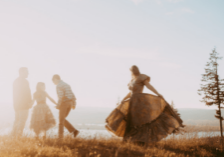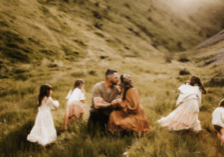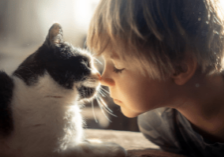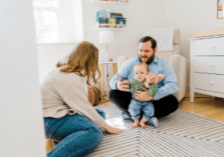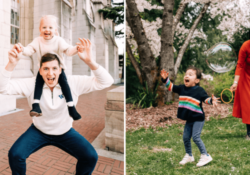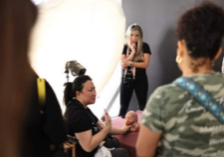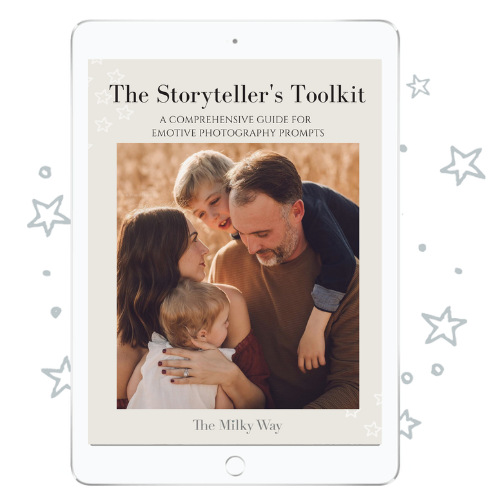Better Together: How Hiring a Team of Associates Can Help You Grow Your Photography Business With Jill Smith
Do you wish that you could outsource some of your photography work? Hiring associates is a great way to say “yes” to more clients while still working less and focusing solely on your zone of genius!
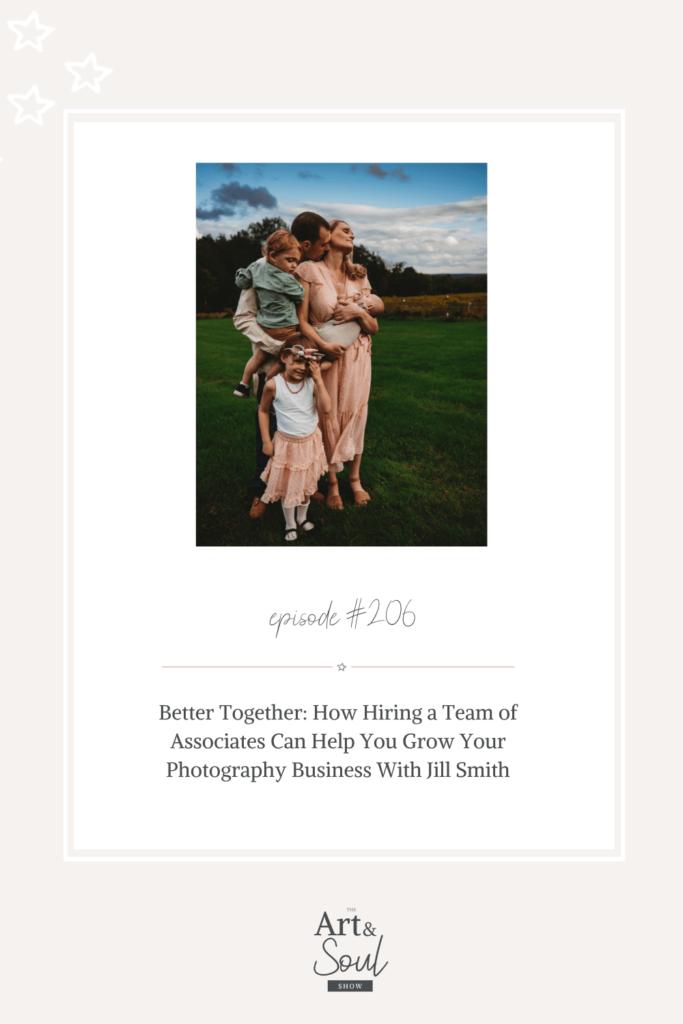
In today’s episode, I’m interviewing Jill Smith, a professional family photographer who has been able to scale her business by building and training a small team of associates. We cover everything from having a community over competition mindset, to streamlining workflow, to how Jill’s own journey has influenced her approach to mentorship. If you want to work less, make more, and be able to channel all of your creative energy into a specific niche, then hiring an associate photographer might be for you!
So, get cozy, grab your notebooks, and tune in. I’m rooting for you, my friends.
What’s in this episode:
- [02:30] Associate photographers and the community over competition mindset
- [08:17] How to successfully hire, train, and pay associate photographers
- [13:46] Leveraging associates and software to streamline workflow
- [19:04] Strategies for navigating challenges and growing your team
- [24:19] Insight into the details of mentorship and marketing
Tune in to this episode to learn how having a team of associates can help you scale your photography business.
SUBSCRIBE: Apple Podcasts | Spotify
Resources Mentioned
Meet Jill Smith
Jill is the lead photographer, and owner of Jill C Smith Photography. She started this journey in 2010 when she was still working as an ESL teacher in Buffalo.Her contract ended and she was given the opportunity to pivot her career. She left Buffalo, moved to Sullivan County, and took her security from her old apartment to buy her first DSLR, a Nikon D90. She made a deal with herself that if she could make this photography thing a full time career by the time her youngest kid was in school, she didn’t have to go back to working for somebody else. Everyday she’s thankful to wake up to do a job she loves and be her own boss. Her favorite thing about being a photographer and small business owner is definitely the creative freedom! When she’s not working on my business in one way or another, you’ll probably find her in her garden, hanging out with her chickens.
Connect with Jill
Did this episode provide you with valuable lessons for how to hire a team and scale your photography business? Check out this episode The Secrets Behind a Successful Husband and Wife Photography Team with Christina Merez that offers you even more insight on finding alignment in your business!
Transcript
[00:00:01] Jill Smith: People who are not my associates, but local photographers that do the same thing that I do. There are some of my closest friends. We tell each other our favorite shooting spots and our favorite gear, and our favorite like tricks of the trade and things like that. And nobody is derailing each other. There’s like, so much work to go around. There is so much work. It’s better to just help other people around you and let them get to where you are so that your entire local industry is elevated. And there’s a new standard for what a family photographer looks like and costs and everything like that. [00:00:31][30.8]
[00:00:35] Lisa DiGeso: Welcome to the Art and Soul Show, where we dive into heart opening chats on photography, business, life and that messy in between. I’m your host, Lisa DiGeso, a mom, a photographer and entrepreneur, and I’ll be sharing honest conversations and advice for photographers with insight on mindset, entrepreneurship, and creativity. The goal of this podcast is for you to be able to gain insights and strategies that will get you real results. Because let’s face it, having a photography business can be lonely, but it doesn’t have to be. This is the place you can go when you need a boost of encouragement, a kick in the pants, and inspiration to pick up your camera. This is the Art and Soul Show. [00:01:17][42.3]
[00:01:18] Lisa DiGeso: Hello my beautiful friends, and welcome back to the show today I’m really excited to dive into today’s conversation with Jill Smith. Jill’s a lifestyle family photographer serving the New York Catskills and Hudson Valley for over ten years. She’s managed to break six figures in her business and work less by building a small team of associate photographers. She’s a family photographer who teaches other family photographers how to build a team of associates for their business so they can work less, make more, always spending more time with their family and friends while staying in their zone of genius as photographers. Now, if you’ve ever been curious on expanding your photography business to include associates, well, my friends, this is the episode for you. So without further ado, here’s Jill. Let’s dive in. Welcome. [00:02:05][46.6]
[00:02:06] Jill Smith: Hey, Lisa. Hi. [00:02:06][0.7]
[00:02:07] Lisa DiGeso: Hi. So tell us who you are and what you’re passionate about. [00:02:10][2.8]
[00:02:10] Jill Smith: Like you said, I am a family photographer and based in the New York Catskills. So I’m about 90 miles north of New York City. And I am obsessed with creating connected family photos that make people feel something. I’m not a perfectionist by any means, and I’m just more interested in, like, the connection and really like honest photos. [00:02:29][19.0]
[00:02:30] Lisa DiGeso: Love that. So it was so interesting because I hear about associate photographers, but you don’t really hear that many bring them on and do it successfully. So I want to hear about you, your business model, and how you dove in with associate photographers and really how you made that decision to bring them on. [00:02:47][16.2]
[00:02:47] Jill Smith: Yeah. So it all started, uh, a few years ago. It was during the busy season. Like I said, I’m in New York. So that’s mid-October is when we hit peak foliage and I got a stomach bug. This is very dramatic, and I’m not a dramatic person, but I got a stomach bug. I got so dehydrated that I passed out, and I got a concussion and a staple in my head, and my tooth broke, and it was like October 12th or something like that. Oh, gosh. Yeah. So like I had I was in the hospital, I had a concussion, so I couldn’t even edit I and by the time that I would be able to get people back on my calendar, the leaves would be gone. And it was my husband who was like, you know, think about when we hire contractors to come and do work for us. The good ones always have a team. They always have people who can come and do their work for them, and then they just supervise who’s like, why don’t you have that? And it it dawned on me then it was like, aha! Of course, like I had been looking for ways to scale my business for a really long time and, um, kept kind of missing the mark. And this seemed like the solution. So that’s how it started. [00:03:51][63.2]
[00:03:52] Lisa DiGeso: I love that. Yeah. Now, I think when someone is even considering bringing on associate photographers, there’s a lot of fears. There’s like a fear of losing control of your business, not being in control of the work they’re doing. And honestly, probably the biggest one is training your competition. So what advice do you have for sort of alleviating those fears in someone who’s maybe considering it? [00:04:12][20.9]
[00:04:13] Jill Smith: I think I love that, I love that you said that because that’s what everybody is secretly thinking. But not many people are willing to admit that there’s actually afraid of with with like, bringing on associates, like, am I going to train somebody for them to go and steal my business and then derail me? I have a couple of angles where I come at this from. I’m a big believer in abundance and community over competition and all that sort of thing. But that’s it’s easier to just say those things than really believe why they they should be like a pillar value in you as a business owner, where no matter what, our market is going to have new low price photographers coming on the scene and and with technology being as accessible as it is now, there’s more good ones than when we got started. Right? So like now the new photographers are also good photographers very often, but they’re normally like not charging enough or not running their business well and things like that. So I see this as an opportunity to kind of take those people under my wing and to say, like, here’s how you can run your business effectively. And yeah, they’re going to turn into competition, but it’s gonna be good competition. Yeah. So what what better motivator than to continue to improve and to have a good business and to offer something good then buy how? I think somebody who’s offering some good competition and, um, kind of motivating you to do that. That said, the people I’ve trained and all that. They’re not stealing my business. You know, you if you have a good working relationship with your associates, they’re not looking to do that. There’s actually very few people who are able to have a full time photography business or, or looking or want to have that desire. So very often, like the people who I bring on have full time jobs like their dream careers already, and they also like to do photography. So there’s that. Every so often there are those who want to go full time, and that’s okay too. Like I said, you have to be okay and aware of of the fact that the competition is going to be there. If you can be allies with them, then the shady stuff is not going to happen as often. The community, um, that I have with my competition, like the, um, people who are not my associates, but local photographers that do the same thing that I do. They’re some of my closest friends. So it’s like, and we we tell each other our favorite shooting spots and our favorite gear and our favorite, like, tricks of the trade and things like that. And nobody is derailing each other, you know? The other, other thing that you have to consider is that, like you and many other photography educators are selling and sharing their secrets. Yeah, and nobody is thinking anybody else’s. There’s like so much work to go around. There’s so much work there. I mean, I could go on and on as to why, um, we don’t need to feel threatened by this. It is. It’s better to just help other people around you and let them get to where you are so that your entire local industry is elevated. And there’s a new standard for what a family photographer looks like and costs and everything like that. [00:07:18][185.4]
[00:07:19] Lisa DiGeso: Yeah, I love that answer. I love that because you’re really embodying the community over competition mindset and really living that. I love that so much. Yeah. You know, it’s funny because we also assume that everybody wants to have a photography business, and that is not necessarily the case. Some people just want to go shoot. So you’re providing an opportunity for these people to have that experience, to be the photographers that they want to be. So the headache of the running the business. Right. [00:07:45][25.5]
[00:07:45] Jill Smith: Exactly. And like it took me ten years to get to the place where I am, where I attract enough business to keep my business going. It takes a really long time to get there. So my associates are really new, and it’s going to take them a while to have that sort of reach anyway. So here they can get the shooting experience. They’re making more money than they can realistically charge uh, by shooting for me. So it really is like it’s a really great opportunity for them. They don’t want to screw it up. So I don’t know. It’s like a symbiotic relationship. I’m helping them. They’re helping me. [00:08:16][30.6]
[00:08:17] Lisa DiGeso: I love that. Now do you find having matching styles like how how does that how is that something that you manage with that. [00:08:22][5.9]
[00:08:23] Jill Smith: So I’m I’m editing. So that’s taken care of. [00:08:27][3.8]
[00:08:27] Lisa DiGeso: Perfect. [00:08:27][0.0]
[00:08:28] Jill Smith: I’m not like a hyper poser. Really I am life style. So it’s post but it’s it’s not meant to look post and all that. I train my I mentor my associates to do my poses. They they learn a workflow of of poses for maternity and family sessions that they go through so that their work resembles mine to an extent. Sometimes one of my associates, her work, like her own personal work, will come up in my feed and I’ll think it’s mine. So she’s she’s been able to really emulate my style. Like I said, these are all things I’ve learned from other educators. And then kind of like, you know, you you make a conglomerate of of what you’ve learned from others, everything that you like to make up who you are. And then that’s going to happen for them too. But yeah, it’s not that important. It’s so much more important their energy and their interpersonal skills. Yeah, I can teach the other stuff. I can teach you like my angles and my poses and all that stuff. And as long as you stick to that and you’re not going your own way during your sessions with me, it’s good. But it’s the stuff I can teach as their their social skills and the and if they like people or not. [00:09:34][65.6]
[00:09:34] Lisa DiGeso: And you know, what’s funny is I just actually signed up for master class because I found I was scrolling on TikTok way too much and I was like, I need to do something in the evenings where I’m not doing the endless scroll. So I signed up for Masterclass and I watched one on Richard Branson, and he had the advice of when you’re hiring someone, take them out to lunch first and watch how they treat other people and what right. And I was like, that is brilliant. And just like, watch how they are with people before you even consider bringing them on. And I absolutely such good business advice. Right. [00:10:04][30.3]
[00:10:05] Jill Smith: But specifically out to lunch because the way that people treat service providers, especially if they like, think they’re below them, you know, I think that’s like that is so telling. It is so, so telling. That’s a good one. I’m going to I’m going to do that right. I was. I think. You recognizing right I was like that. Thanks Richard I love that. Yeah. Seriously. [00:10:23][18.1]
[00:10:23] Lisa DiGeso: Uh so how do you structure paying them? Is this something where they’re getting the full entire session? You’re taking a cut? Like, how does that work? [00:10:32][8.4]
[00:10:32] Jill Smith: Yes. So I have ADHD and I can’t like I understand that subcontractors can be 1099. I don’t know if Canada has the same sort of like tax structure and payment structure that we do. So a 1099 employee is like, I would have to fill out a special tax form at the end of the year if I’ve paid somebody like the hairdresser across the street when she does hair and makeup for me, for my my clients, I pay her and then, you know, it’s a 1099 and end of the year to avoid that at all because my associates are getting paid so often. I have the clients pay their retainer directly to them. So they have. Yeah. So they have their own calendly links or whatever booking software they use, and they collect either 300 or 350 upfront. That’s the flat rate for a regular family session for my team, and they collect it directly from the client. If there needs to be refund, that’s on them. They they take care of that and the money never passes through me. So I don’t technically need to even 1099 them. It is very streamlined. And then I invoice the client the balance. Um, and I let them know at booking like you’re, you’re working with an associate, you’re going to get you’re going to pay them directly and you’ll get an invoice for me. [00:11:41][69.2]
[00:11:42] Lisa DiGeso: So love that. Now is your business model of digital or do you like hybrid. Do you do I do all inclusive. [00:11:48][5.9]
[00:11:49] Jill Smith: So once again ADHD. I have tried so many models and I do I appreciate the appeal of like a um of apps or, or even and a digital version of apps. But I need to have like less steps to my entire like client journey for me to follow through. So and I also got burned a couple of times, people booking me and my busy season and paying the session fee and then not buying anything. And I’m like, nope, can’t have that happen anymore. So now I just charge a lot of money and it’s all inclusive. [00:12:18][29.3]
[00:12:19] Lisa DiGeso: Yeah. I love that. I was really similar. I have a similar business structure where I kind of kept increasing it and I was like, you know, if I want to include like a print, I just I tried doing prints for a while and I was like, I think this for me. And then I found these albums that I really loved. And I was like, well, what I want to do is if I want to do albums, I’m just going to include it in the package and say, this is my package of digitals. That includes an album period, full stop, 20 page spread. Yeah. That’s it. [00:12:43][24.4]
[00:12:43] Jill Smith: That’s what I’m going. That’s what I’m doing next year is I, I want to raise my prices a little bit, but I do want to include the album. Yeah. Um, so that’s what I’m going to be doing. We’ll see how it goes. Yeah. You could trade notes. [00:12:54][11.0]
[00:12:55] Lisa DiGeso: Seriously, let me know how it goes. There is an album company that I found last year that I fell in love with, or a quality, and it’s called Wooden Banana. [00:13:02][7.2]
[00:13:03] Jill Smith: I’ve seen them. [00:13:03][0.5]
[00:13:04] Lisa DiGeso: Their Velveeta covers are. Yes. Oh my gosh. And so nobody else has those. Yeah, yeah, I got the sample albums of them and like the price was pretty decent. [00:13:14][9.6]
[00:13:14] Jill Smith: The price is better than the lab that I use. [00:13:16][1.6]
[00:13:16] Lisa DiGeso: Right. Um, quality. Like I’ve been showing them to my clients. They’re like, I want all of these. And I was like, this is awesome. So definitely check out Wooden Banana. I’m not even. [00:13:25][8.7]
[00:13:25] Lisa DiGeso: That’s awesome. I mean. [00:13:26][1.2]
[00:13:27] Lisa DiGeso: There’s no affiliation with them. [00:13:28][1.1]
[00:13:28] Lisa DiGeso: Like, I love you wooden bananas. [00:13:30][1.6]
[00:13:30] Jill Smith: Like, yeah. Oh, I’m going to check them out okay. [00:13:33][2.7]
[00:13:33] Lisa DiGeso: Sure. Yeah. And like the velvet like, oh like in the colors are so yummy and dreamy. [00:13:38][4.1]
[00:13:38] Jill Smith: So yeah, I love velvet because I don’t like those linen types. They get stained so easily. They always get like marks on them. Velvet is much more child friendly actually. [00:13:46][7.7]
[00:13:46] Lisa DiGeso: Yeah, yeah, I love velvet. I just like I like the look of it. Yeah. So managing a team of associates really allows you to work less. Can you share the impact this has had on your work life balance and your ability to spend more time with your family? [00:13:58][12.5]
[00:13:59] Jill Smith: It is. It’s like tipping the scale for my work life balance. I’m. I am home again. I am like there on weekends. I’m going to barbecues, I’m going to soccer games. And just as important, like because I do like working, I love what I do. Otherwise I would go back to working for other people because there’s a lot that’s a lot that’s easier about working for other people. Um, I can just focus on taking the jobs that I really like. The things I feel like are in my zone of genius, the things that light me up and that move the needle for my business. And, you know, the more that you like niche down, for me, at least, the better I get at those things I like. If I can just do the same types of sessions, for the most part, I get really good at those. And then when I start to like mix in a variety, it’s like it really waters it down and I don’t. Not that not good. But anyway, yes, I do. I like home with pants that don’t button. I no bra all the time now. It’s really great, I do, I love to be able to be home. I love when I don’t have anywhere to go and that I can, like run my business from my couch and it’s good stuff. [00:15:00][61.1]
[00:15:01] Lisa DiGeso: I love that. So do you have any thoughts on outsourcing the other day? [00:15:04][2.8]
[00:15:04] Jill Smith: Yeah, so I have tried outsourcing. Now I am apparently am a very fast editor, so if I shoot a 20 minute session, it normally takes me about 20 minutes to upload edit, deliver. So like what? Or like same thing for an hour session. That said um, that’s because I use like I calling that since implementing eye calling I. [00:15:25][20.5]
[00:15:25] Lisa DiGeso: Know it’s amazing. [00:15:25][0.3]
[00:15:26] Jill Smith: Yeah. So my next step this winter actually I’m going to learn how to use that. I um they I. Editing because you do have to like train it with like. Yeah, crazy. Amount of photos like 5000 or something. So yes, I am going to learn how to do that so I can really streamline it because it’s getting to. Yeah, the the back end of everything is getting really efficient. [00:15:48][22.1]
[00:15:49] Lisa DiGeso: And yeah, it’s so nice. Think back to when we first started. Like it was like hours and hours and hours like one photo at a time. I remember like when bridge or not bridge Lightroom and you’d have to pull it up and just sit there and wait for everything to render. And you’re just like, I guess I’m just going to make dinner now. [00:16:03][14.8]
[00:16:04] Jill Smith: Like so I am like an outlier where I use Adobe Camera Raw. [00:16:09][5.1]
[00:16:09] Lisa DiGeso: Oh. Same same. Oh you do I have always use ACR and I love it. And so that’s the part I find frustrating with some of these softwares is because they don’t have exactly right. [00:16:21][11.4]
[00:16:21] Jill Smith: And I’m and that’s why I need to spend the winter to learn how to use Lightroom. And how to I know. Yes. So now it’s like a new thing, and I’m finding more and more legitimate photographers who are using ACR. So I feel less, less weird about. [00:16:34][12.5]
[00:16:34] Lisa DiGeso: Yeah, no, I love I have always loved ACR. I’m really proficient in Lightroom, but for some reason I feel like ACR is more efficient for my workflow. [00:16:43][9.2]
[00:16:44] Jill Smith: It’s so fast for me like. Yes, it’s so fast for me, I don’t. I don’t know if there’s something I’m missing. I know, I don’t know why. Like the majority seems to love Lightroom, but yeah, ACR is like where it’s at. [00:16:54][9.9]
[00:16:54] Lisa DiGeso: For me because my workflow would be like I pull up like I call them in photo mechanic or um, oh gosh, what’s the new and after shoot. After shoot? And so I use either one of those and then I pull it into like the group of like 50 or whatever, I pull them into ACR altogether. Then I send them, um, do all my edits, save them as psds, run my actions on them, and then use Batch Plus and go through each one individually. And it’s like, damn. [00:17:21][27.3]
[00:17:22] Jill Smith: Very similar to what I to what I do. Yeah I, I after shoot and then like I have to close it and then open it up and go through all the ones that are selected for green. Apply my favorite preset. I think part of like being a fast editor is I almost always use the same preset. I don’t like spend a lot of time experimenting because I have something that works and yeah, apply it. And then like I do this weird thing where I batch delete all of them, like I mark them for all for deletion, and then I delete the ones that I want because it’s normally am normally going to delete more than I’m not. [00:17:53][31.3]
[00:17:54] Lisa DiGeso: Yeah. [00:17:54][0.0]
[00:17:54] Jill Smith: And uh, make little tweaks there and it can be really. And I got a very fast computer this year. So I, I recognize that that’s part of my speed. [00:18:02][7.2]
[00:18:02] Lisa DiGeso: Huge. So what did you get. Are you math. [00:18:04][1.5]
[00:18:04] Jill Smith: I am I have um it’s a it’s a MacBook Pro. Yeah. It’s I’ve which is what I’ve had in the past. This one has 96GB of Ram. [00:18:12][7.4]
[00:18:12] Lisa DiGeso: Nice. [00:18:12][0.0]
[00:18:14] Jill Smith: Might be overkill, but it is like I bought time with it. Like I paid for time in my life, so that’s worth it. [00:18:20][5.8]
[00:18:20] Lisa DiGeso: Yeah. I’ve been looking at the Mac studio, I think it’s called, and I was like, I just want something with because I do a lot of video editing too, right? Like want something really goofy. So yeah, these new like 24 I, I’ve got a 24 inch and I’m just like, I don’t know if this is as simple as it needs to be. [00:18:34][14.1]
[00:18:35] Jill Smith: So is it like an I have an iMac at home too, but my kids have kind of like stolen it to play the Sims and stuff. So like waving the white flag there. Yeah, but a photographer I talked to just got the Mac studio with a giant screen. Like, I bet that’s going to be fun. [00:18:49][13.8]
[00:18:49] Lisa DiGeso: Yeah, I said, I, I’m looking forward to that. So that’ll be on bucket list for 2024 Black Friday. Now we like deep on on tech. [00:18:56][6.8]
[00:18:57] Jill Smith: I know and I don’t even think I, I don’t think I cared so much that tech. But I guess I care about I care about the tech that makes my life better, right? [00:19:03][6.2]
[00:19:04] Lisa DiGeso: Fast tech I love it. Yeah, I love it. Okay, so when you’re transitioning to a team based model, what challenges if have you found you’ve encountered and how do you kind of navigate them for success for your whole team? [00:19:17][13.6]
[00:19:18] Jill Smith: Yeah. So I mean, the number one challenge that I found was figuring out how to do it in the first place. Like when I was doing this, everything I could find about photographers bringing on associates was geared towards wedding photographers, and there’s some differences there. Yeah. So it was a ton of research and like piecemeal, the information that I got from different sources together to make it work. From there I’ve had to get better about delivering. It’s, Lisa, it’s family photography. So it is not surgery. Nobody is killing anybody if they mess up at work that day. But like when somebody delivers, you know, one of my associates makes a mistake or there’s something that we need to talk about so that we don’t do that again. I’ve never I’ve usually avoided those conversations. And as a solopreneur, I don’t always have to have them with people who don’t live in my house. So so finding ways to to communicate that, uh, to my team without them taking offense or I don’t want anybody to feel bad or think that they’re, like, in trouble. Yeah. Just because there’s a problem there. ISO was high or you cropped somebody at the ankle or something that’s like, let’s, you know, just move forward. Yeah. But I’ve, I’ve gotten I’ve gotten good at. I think because nobody’s quit. [00:20:34][75.8]
[00:20:34] Lisa DiGeso: And I love that. Yeah. So how did you find your associate photographers? [00:20:39][4.8]
[00:20:41] Jill Smith: So I have three associates, and I have each. Each of them. I found a different way. Uh, the first one I kind of cold called. She was the first person I thought of when my husband gave me that idea. And I actually called her. And I told her what I wanted to do, and she was really excited and surprised, and she was nervous. And I remember I said to her, I’m like, Allie, I’m not a unicorn. And just go, what? You understand? You are, because she’s so much younger than me. She thinks what I’m doing is like some unattainable thing. I’m like, no, you don’t understand. Like, my first bits of work that went out to the public are so much worse than yours. I had to figure this out to like. And if I can figure it out, I can show you how to figure it out, too. And we can get you there, and you’ll be great. I said, I’m most concerned about your character, and I like you. I know that you’re going to do a great job. Um, the next way was, I knew I wanted to have two people, so I put out an ad on Facebook. Jobs which you can’t do anymore, I guess. Which stinks because yeah, it was actually really good. So people would apply. And I conducted a lot of interviews, actually, and narrowed it down to one photographer. I brought them into my studio and we we had, you know, we met and I watched them shoot. I wanted to make sure they could shoot manual and if they couldn’t show them how, because that’s honestly pretty easy stuff to teach. Um, the third one reached out to me. She’s somebody that years ago took a course that I offer and how to shoot in manual. Believe it or not, she’s an art teacher. After taking the course, she got really into photography and she took a bunch of courses with, like, hers and Lewis and like, she is a, um, documentary style photographer. Wonderful. And she. She won awards and she started a business and did not like the business. So she’s just been sticking to her day job at the school, but was like, I still want to shoot, but I don’t like running a business. So if you want another associate like I would be game. So that was an easy yes for me. So yeah, I, I think if I were going to do it again, if I needed to find another associate, I would probably start by, I’d probably like cold Call like I did with Ali. Observe, see who’s like doing things you like. And then now I think I would take them out to lunch too. [00:22:47][126.3]
[00:22:50] Lisa DiGeso: I love that, I love that I. Think it’s, it’s I love the conversations I get to have on this podcast, because I really think there’s not just one way to run a photography business. And I think it’s so important that our listeners and our students really, you know, embrace that, that, you know, if you wanted to be an associate photographer or if you wanted to have associate photographers, that is an absolute option if you want to do IPS or if you don’t want to do IPS and do all digital, it’s all options. [00:23:17][27.1]
[00:23:18] Jill Smith: Yes. You know. Yeah, this this photographer I know who is she’s very, very green. Like she just got started and bought her first camera this year. And she reached out to me yesterday wondering if I thought she was leaving money on the table by not doing a session fee plus. So I said, there is more than one way to skin a cat. Like there is really not a right way or wrong way. You have to try them out though, because you need as little freaked. I need at least I need as little friction as possible. It needs to feel organic. It feels natural to me and um, like I have tried to switch back and forth and it turns into a lot of reeducating my clients like, okay, and guess what? This year we’re going to do things a little differently, and it’s a pain in the butt. Like nobody wants to do that. Nobody needs to be confused. So there is there are so many ways to do this well and to do it right. And one way is not better or more profitable necessarily than the other. Um, I work very few hours and I make a pretty healthy income from it. And I think that for me, the all inclusive model works great because of that. [00:24:18][60.0]
[00:24:19] Lisa DiGeso: Yeah, I love that. So let’s talk about getting into mentoring a little bit, because that’s something that I know that you are starting to do. So how has your own journey as a photographer influenced your teaching approach when mentoring others in the photography industry? [00:24:33][14.7]
[00:24:34] Jill Smith: So, uh, like I said earlier, like I feel like and I know it just looks like this sometimes, but I feel like with the tech being where it is and cameras being more affordable, that it doesn’t take as long for people to to become really good photographers anymore. Right? It felt like it took me a long time to get to be a decent photographer and a decent business person, but I get so excited about what this career has given me. And when I see other people like even thinking about doing it, I’m like, yeah, come on, let’s like, let me show you how. Yeah, because this is the best I, I am. Um, I was just at Career Day for my kids school yesterday and talking to these kids who all think they have to go to college or a trade school or something like that to make good money. And, you know, our salaries are written right there in our little poster and everything. And the kids are like, you make what you’re a photographer and you make shots. And I’m like, more than photography. Like, I want you to think about what you do that. You love what you do that can help other people, and you can turn that into a small business being, you know, your own boss. For me, I can’t imagine going back to work. So when I my, my entire career, my everything about like my lifestyle now because of owning my own photography business gets me so excited for other people who are just getting started out. And I want to make sure that they know they can do this too. This isn’t like some you don’t need some secret or any magic or anything special to get here. You can do it too. And that’s what motivated me to start mentoring other people. And you know, I tend to like info dump and give a lot of unsolicited advice. So I figure if like, I can just find the people who actually want to hear me. [00:26:19][104.2]
[00:26:21] Lisa DiGeso: It’s better. I love that. Now, how are how do you market with having associate photographers? [00:26:25][4.9]
[00:26:27] Jill Smith: Yeah, so I actually don’t. And this might change. Maybe I’ll like start being more intentional about marketing them because of where I am with my business. I have a lot of leads that come in that I would would that I used to say no to. Yeah. So now those leads I say yes to in a different way, like, yes, um, I well, I won’t be the person photographing your proposal or your bar mitzvah or your senior or things like that. I have this associate who is really good. And let me show you her portfolio. She’s a little less expensive than me, so that’s a nice perk to that. I think it’s, you know, if anybody has a it’s not it’s not a big it’s probably like 25% cheaper that my associates are than me. But um, if anybody has concerns over price, yeah, that can be a nice little option for them. So it helps them say yes to more people. But no, I don’t I don’t really even post their work that often unless it’s to advertise a specific event. They’re doing like one associate likes to do family mini sessions, which is great because I decided this year I really, really don’t like doing them. So I will advertise her many such session work for the the previous year and that sort of thing. And they do have their portfolios on my website. Yeah, but I just market as usual. And uh, the extra leads are coming in and instead of like going to my little group of photographer, like our group chat and like saying, hey, does anybody want this job? I can’t take it. Yeah. I go to my associates and I say that. [00:27:54][86.6]
[00:27:54] Lisa DiGeso: Yeah. And then it kind of becomes fun to matchmake, too, I’m sure. [00:27:56][2.5]
[00:27:57] Jill Smith: Right it is, it is. And my team has. I don’t know. Chiefs. I think this is kind of an accident, but they are really well-rounded. Like my one associate is a wedding photographer who can also do family work. But so when I but when I get the proposals and the couples and the engagements and things like that and like that’s an easy, easy for you. Hira Ali is like, does everything that I do, so like family, work and that sort of thing. And, and then Jenna does the documentary sales. So like in home, family and newborn and stuff like that. Like she’s better than me at that stuff. So it is really exciting to just feel like we have this group now of specialists. Yeah. Who? It’s not just like we’re I’m the best one. And there are kind of good. Like each of them is better than me in their own ways too. So it’s it is really awesome. [00:28:43][46.2]
[00:28:44] Lisa DiGeso: Uh. Great. Sounds really symbiotic. That’s awesome. [00:28:46][2.2]
[00:28:46] Jill Smith: It is. Yeah. [00:28:47][0.5]
[00:28:48] Lisa DiGeso: So looking ahead, do you have any goals or projects as having this associate photographer business that you’re really excited about that you would like to share? [00:28:56][8.0]
[00:28:57] Jill Smith: Yeah, I am excited to be offering a course now to teach other photographers who are at a stage in their business where they’re ready to bring on some, some associates. I don’t think it’s something that many family photographers even think of as an option, but there’s a lot of different reasons that this could be right for somebody. For example, my studio partner is like, yo, she’s a newborn photographer and that’s really all she wants to do. She doesn’t want to be work, do the family work or the maternity work anymore, and she’s going to be training somebody to do that sort of work so she can keep taking it. Because, you know, those things can turn into newborns. Yeah. And they can kind of continue to generate if you can kind of like keep those other things in house. So there’s a lot of ways that this could work for somebody. A lot of people probably think like they’re not at this stage in business to. Yeah, have the overflow of work. But there’s a decent chance that that they are, you know, if you find yourself saying no even just during busy season, then you could have an associate just during busy season. Yeah. But yeah, that’s that’s what I’m working towards. Because like I said, I get very excited. You know, if I find like a shampoo I like, I’m going to talk your ear off about it and encourage you to try it. By the way, I haven’t found a shampoo I like, but. So if anybody has any recommendations. But um. But that’s like so this is something that has been life changing for me. Yeah. You know, it, it broke my income goals for me. Awesome. And like brought me into new territory that way. And you know, the community I can’t, like, forget to talk about how nice it is to have this. Team and like they come out to lunch with me. This is, this is now that I know them. But we go out to lunch together. We’ll go out to dinner together. We’ll do things like that just for fun. And it’s nice to have that team, um, I help them with their businesses. I want to see their businesses do really well, too. Yeah. Um, and obviously they help me with mine, so it’s not. Yeah. I just I would encourage any family photographers or any photographers to, to consider this as an option for their business. [00:31:01][123.8]
[00:31:01] Lisa DiGeso: Yeah, I think it’s fantastic I love it. So you ready for our lightning round. [00:31:05][3.5]
[00:31:06] Lisa DiGeso: Yes yes yes. [00:31:07][0.8]
[00:31:07] Lisa DiGeso: What’s your favorite movie? [00:31:08][0.7]
[00:31:09] Jill Smith: I think it’s what’s eating Gilbert Grape. [00:31:11][1.4]
[00:31:11] Lisa DiGeso: Oh, it’s a good one. [00:31:12][0.6]
[00:31:12] Jill Smith: Yeah, yeah. [00:31:13][0.6]
[00:31:14] Lisa DiGeso: Uh, favorite. Guilty or not so guilty pleasure. [00:31:16][1.9]
[00:31:17] Jill Smith: Trash TV like, you know, junk food for your brain when you don’t want to think like, I really like Real Housewives of New Jersey. I’m really trash. [00:31:24][7.7]
[00:31:25] Lisa DiGeso: I think, diving into that. But I’ve been really into Kardashians lately, so yeah. Yeah, I’m really into them. [00:31:30][5.1]
[00:31:30] Jill Smith: And you haven’t, like, lost faith in humanity? [00:31:32][1.6]
[00:31:33] Lisa DiGeso: No. Jokingly. I actually really like them. And I’m like, really? I seriously, you should watch the Kardashians, okay? I’m just like, shockingly surprised. And now I’m like, like a superfan. [00:31:42][9.5]
[00:31:43] Jill Smith: Okay. Yeah. All right. Sorry. Can I close me here? Okay. [00:31:51][7.4]
[00:31:53] Lisa DiGeso: Oceans or mountains and why? [00:31:54][1.2]
[00:31:55] Jill Smith: So I grew up on an island, and I spent the first 25 of my year, like, years of my life on or in the ocean. But I live in the mountains now. I came up here and I settled down. Yeah. And I think the mountains wins for me. Um, yeah. The mountains are steady and constant and they provide safety. I know they protect us from the weather and things like that. And the ocean is beautiful, but it’s really powerful and it’s always changing in it with bring in hurricanes and things like that. So I’m gonna say mountains. You say mountains. [00:32:23][28.0]
[00:32:24] Lisa DiGeso: So what island did you grow up on? [00:32:25][1.1]
[00:32:26] Jill Smith: Uh, Long Island. Oh, do you know, do you know Long Island? [00:32:29][3.2]
[00:32:29] Lisa DiGeso: Not really, but I could talk a few times. And actually, here’s a funny story. So we we flew into JFK because his partner and I, and we were going to a business retreat in the Poconos, so. Right. So we took. [00:32:43][13.6]
[00:32:43] Jill Smith: It would probably be the Catskills. I’m like, well, could Pennsylvania is the Poconos. Where are you in Pennsylvania? [00:32:47][3.6]
[00:32:48] Lisa DiGeso: Okay, it was Sky top. Oh, sure. Yeah, that’s actually very close to me. We took an Uber from JFK. Oh, God. He was like. A scenic. Route. He had never been out of the city. It was. You were terrified. [00:33:01][13.0]
[00:33:01] Jill Smith: And it’s really. It’s actually like. So for somebody who learned to drive in, like on Long Island at, like near the city, it is really scary to drive up here because the people up here are going really fast and these little narrow, winding mountain roads and I’m like, no. The speed limit was 55. Like, I need to slow down like I can’t see. [00:33:19][17.2]
[00:33:20] Lisa DiGeso: You didn’t realize it was going to be like a 3.5 hour trip like. And we were like, oh, right. Sorry, sir. Pay day. Kidding. I was so funny. I was like, he was like, I think I probably should. Have like quoted more for this. Oh, poor. Guy. Yeah. Of course. Guys, um, what’s the best gift you’ve ever received? [00:33:37][17.5]
[00:33:38] Jill Smith: So I this is a hard one, but I think back to, like, the most thoughtful gift I’ve ever received. I was in high school, and my brother saw me rubbing like a perfume sample on myself. And like, every day I would rub. Because I was in high school, I didn’t have money, right? Or like, rub this stamp. And I really liked it. And he didn’t say anything. He just went and he took the sample and he saw what it was, and he went and he bought the perfume. And he totally surprised me that Christmas of like, he’s such a good gift giver. Like he’s so thoughtful and and he notices so much. So I think that was like one of the most surprising and thoughtful and like, a gift that, I mean, that was probably 15 or 20 years ago now. That and I still remember it and just get it tear up when I think about it. [00:34:23][44.9]
[00:34:23] Lisa DiGeso: Oh, that’s so sweet. I love yeah, I love that. What are you most grateful for in the season of life? [00:34:29][5.9]
[00:34:30] Jill Smith: My husband and I just always it’s always my husband. He’s been a constant blessing in my life. Um, he’s always supported me, and he. I just, you know, I, I think the world of him and I don’t take for granted that I found him. And because we’re such a perfect match for each other. But like when I got pregnant and I was going to pay more for in daycare than I was earning at the time, I was in a I didn’t have a thriving business yet. He was cool with me not going back to work and working on building this while he supported the family and knowing that, I mean, he never gave me a hard time about working late hours and staying up all night to edit inefficiently and like the old Photoshop and like. That ever as and delivering on little CDs and like it was. I wasn’t making any money, but I was spending a lot of time in the business, and he always supported me and he always treated like a big deal. And that’s just the tip of the iceberg with him. That’s my husband. I’m always grateful for him. [00:35:30][60.0]
[00:35:31] Lisa DiGeso: I love that, that’s great. What is something you’ve accomplished as an adult that your younger self would be proud of? [00:35:36][5.7]
[00:35:37] Jill Smith: That’s all of us. Yeah. This, uh, this, uh, life that I’ve been able to build, I get very excited about just about everything, as you can see. But I think it’s. I think it’s so cool and so amazing. And I know that little Jill would have thought this is the coolest thing that, you know, you don’t have to hate work. You can like going to work, and you can make money doing it and have a family that you really like spending time with and live in a cool place and all that. [00:36:02][25.1]
[00:36:03] Lisa DiGeso: Yeah. What three things do you want to be remembered for? [00:36:06][2.7]
[00:36:06] Jill Smith: This is such a loaded question. I really had to, uh, to think hard about this one. Um, I hope people remember me for being honest, supportive, and tenacious. [00:36:15][8.6]
[00:36:16] Lisa DiGeso: Um, good answer back. What has been the best piece of business advice you’ve ever been given? [00:36:22][6.1]
[00:36:22] Jill Smith: This is a really tough one. Um, I think that Elena, as Blaire, has been my mentor for a while now. She’s great. And I think one of the biggest takeaways that’s been the most impactful that she’s told me is to, like, get rid of the limiting beliefs. Stop playing small. Yeah. Think big, think big. Don’t limit what you think your life can be, or what your business can be, or who you can be. Yeah, just dream it, write it down and kind of without being too will find a way to manifest it, envision it and do it. It’s possible. If you can dream it, you can do it. [00:36:58][35.6]
[00:36:58] Lisa DiGeso: Yeah, I love it. Richard Branson again also has this quote, it screw it. Let’s do it. Yeah. Do it. Just do it. Like that’s. It. Just do it. [00:37:08][9.3]
[00:37:08] Jill Smith: And it’s worked for him. Yeah. Clearly. [00:37:10][1.8]
[00:37:12] Lisa DiGeso: What advice do you have for someone who’s just starting out the same. [00:37:15][3.1]
[00:37:16] Jill Smith: Don’t don’t limit yourself. Yeah. Think about what you want this to do for you, why you know and why you’re doing it, and what life should look like in this field. And then reverse engineer that and be intentional and and do the thing. Um. Don’t give up. Failing is good. Failing is really good. Keep failing and learn from your failures. And because each one is going to make you a little bit better at what you do. [00:37:42][25.9]
[00:37:43] Lisa DiGeso: We learn more from our failures than we do our. [00:37:45][1.8]
[00:37:45] Jill Smith: Solutely abs, and it like, it really has to hurt. Like it has to be. It has to be painful. [00:37:49][4.6]
[00:37:50] Lisa DiGeso: Yeah, you learn something lessons and then when the most painful. They’re the biggest one. They are. Yeah. Those are the good one right. At that time when you like, change the quality of your camera from like, raw to like fine Jpeg and then still had to come up with a session. Ever done that? [00:38:05][15.9]
[00:38:06] Jill Smith: Yeah. Never did that. Yeah, I’ve done that. I have done that. My and my, my really good friend just got a new mirrorless camera in the first session that she shot with it. And she’s a she’s been in business longer than me. Um, the first session she shot with it was Jpeg indoor studio. Yeah like newborn. So she was like totally like. Yeah, but it worked out. She figured it out. And yeah, she’s not going to do that again. [00:38:28][21.1]
[00:38:28] Lisa DiGeso: No. And the funny thing is now, because you have the camera raw filter inside Photoshop, you kind of have the side door. So I was like, yes, save me that, save me. This was recent because this was like, actually I only put six months ago when I got my mirrorless and. That the same. So I was like, bro. It was bad. No. Okay. You live to learn. You live. And learn. I won’t do it again, though. Some. [00:38:52][24.0]
[00:38:52] Jill Smith: Some professional photographers shoot in Jpeg only. They do on purpose, so it’s. Likely. It’s not common. But you can do it. It’s better when you know. You’re doing it. Yeah, absolutely. You’re surprises. Right? Right. [00:39:04][11.9]
[00:39:06] Lisa DiGeso: So where can our listeners learn more from you? [00:39:07][1.6]
[00:39:08] Jill Smith: Uh, jillsmithphotography, um, you can find me at that name on Instagram, Facebook and jillcsmithphotography.com. [00:39:14][6.2]
[00:39:16] Lisa DiGeso: Okay. So I love to end my interviews just with this last question. And it is, what are you currently curious about or artistically curious about? [00:39:24][8.4]
[00:39:26] Jill Smith: So you can see I’m in my studio. I have like uh, an all white studio. So like I try to shoot all white spaces, right? Um, and this is something that takes up, you know, the, the cold months when I’m not out outdoors doing golden hour stuff. And I’ve always tried to get the really good white balance that just the tones that Suzy Mitchell get. Yes. Oh my gosh. If do you know, are you familiar with Little White? [00:39:48][22.6]
[00:39:48] Lisa DiGeso: Yes. I’m obsessed with the white tones. I have tried to deconstruct it so many times. [00:39:52][3.4]
[00:39:53] Jill Smith: I can’t, I know. So she is finally offering education and I signed up and I’m going to be doing that this January. So I’m going to really give it a good college try this year because I, I, I cannot, I cannot and she uses the same equipment as me. Yes. So I figure like if yes, she can do it, I should be able to do it. [00:40:10][17.4]
[00:40:11] Lisa DiGeso: If she still has this open. I’m setting up myself because I’ve been trying to deconstruct it for years. I’m setting up today. Right. I, I do that, you know, and. I just love like I do too. [00:40:21][10.7]
[00:40:22] Jill Smith: I do too, and I feel like I haven’t done anything, any education as, like a photographer. Like. Yeah. Not the business end but like for the photography and in a while. Yeah. So I really want to, um, see if I can do that because that is has been escaping me for a very long time now. [00:40:37][14.9]
[00:40:37] Lisa DiGeso: I love that. Well, Jill, thank you so much for joining me today. It’s been a treat chatting with you. [00:40:41][3.6]
[00:40:42] Jill Smith: You too Lisa, thank you so much. [00:40:43][1.4]
[00:40:44] Lisa DiGeso: Oh my beautiful friends. I hope you have enjoyed this conversation just as much as I have. I’m sending you so much of my light and my love today and every single day. We’ll see you next time. [00:40:55][11.4]
[00:41:00] Lisa DiGeso: Hey, friend. You know what’s the worst? It’s just being mid-session and completely freezing. You start to feel awkward, your clients start looking at you for direction, and your brain feels like you just hit a wall. Now, believe me, you are not alone. And that’s why we created the Storyteller’s Toolkit. It’s an emotive prompt guide to help sessions stay free flowing and fun. And best of all, right now it’s totally free. It’s full of prompts for parents, motherhood, family, siblings and couples, and even surefire smile prompts. We’ve put together over 200 prompts for you so you’ll never be lost for an idea again. Grab your copy at themilkyway.ca/toolkit. [00:41:00][0.0]
[2361.6]
share the love
[Sassy_Social_Share]
recent
Podcasts
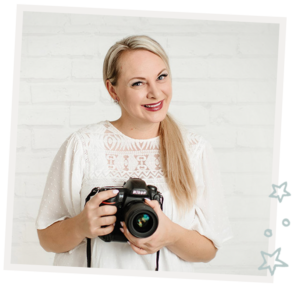
I'm
Lisa DiGeso
I’m on a mission to create uplifting online experiences for photographers ready to elevate their art, their business and their mindset.(...and have fun along the way!)




